The GTI editor greatly simplifies creating a dynamic mesh VPN network with a large number of CloudGen Firewalls. You can enable dynamic mesh for all VPN services directly in the VPN group. To initiate a dynamic tunnel, traffic must match access rules that use dynamic-mesh-enabled custom connection objects on the CloudGen Firewall acting as the VPN hub. Dynamic Mesh is not supported for VPN services using IPv6.
Before You Begin
- For each VPN service in the VPN Group, go to the VPN Settings and verify that Allow Dyn Mesh is set to yes.
- Configure the GTI Settings for each VPN service. For more information, see How to Configure VPN GTI Settings for a VPN Service.
- The VPN service that is to be used as the VPN hub must have all remote and local networks entered as Server/GTI Networks.
- Configure the GTI Settings for the VPN services on the managed firewalls. For more information, see How to Configure VPN GTI Settings for a VPN Service.
Step 1. Create a VPN Group
VPN Groups contain the default settings for all VPN tunnels in the group and the list of VPN services used to create the tunnels.
- Go to CONFIGURATION > Configuration Tree > Multi-Range > Global Settings > VPN GTI Editor.
- Click Lock.
- Click + to add a new VPN Group.

- Enter the Name.
- Click OK. The Group window opens.
- Edit the default TINA settings:
- Transport – Select UDP, TCP or ESP.
- Encryption – Select the default encryption cipher.
- Authentication – Select the default authentication hash.
- Dynamic Mesh – Set to yes.
- Dynamic Mesh Interface – Default is Static. Select Dynamic if the firewall is behind a NAT device.
- Dynamic Mesh Timeout – Enter the number of seconds before a dynamic tunnel is terminated.
- WANOpt Policy – Select NO-WANOpt. WAN Optimization cannot be used in combination with Dynamic Mesh.
- Meshed – Set to no.
- Service Placement – Select Classic circular to automatically arrange all VPN services in a circular pattern. If one service is selected as the VPN hub, it is placed in the center of the circle. User allows the user to arrange the VPN services.
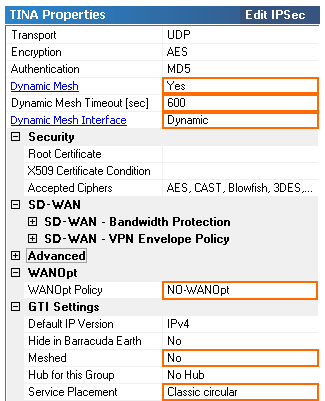
- Click OK.
- Click Send Changes and Activate.
Step 2. Add VPN Services to the VPN Group
Add the VPN services to the VPN group. If you are using the GTI editor on the range or cluster level, add VPN services to the VPN group only from the range or cluster you are in.
- Go to CONFIGURATION > Configuration Tree > Multi-Range > Global Settings > VPN GTI Editor.
- Click Lock.
- In the Group tab, click on the VPN group. The VPN group name is displayed in the top status bar of the GTI map.

- Click on the Services tab.
- In the taskbar, select both Group and Other button.

- Select all VPN services you want to add to the VPN group.
- Right-click and select Add to current Group. The VPN services are added to the map area below.
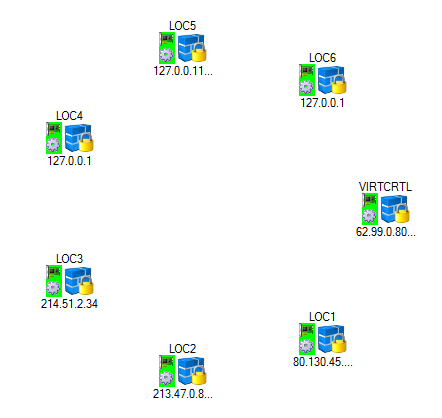
- Click Send Changes and Activate.
Step 2. Select the VPN Hub
Select the VPN service that will act as a VPN hub.
- Go to CONFIGURATION > Configuration Tree > Multi-Range > Global Settings > VPN GTI Editor.
- Click Lock.
- Click on the VPN service you want to use as a VPN hub, and select Hub. The VPN Service icon is re-positioned to the center of the circle.
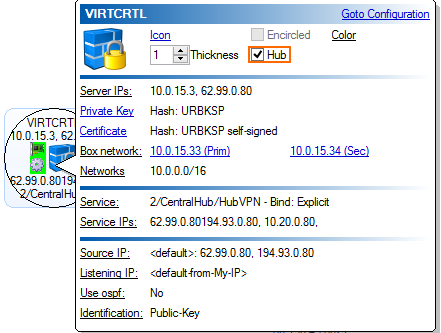
- Click Send Changes and Activate.
Step 3. Create VPN Tunnels to the VPN Hub
Create VPN tunnels from every CloudGen Firewall to the central VPN hub.
- Go to CONFIGURATION > Configuration Tree > Multi-Range > Global Settings > VPN GTI Editor.
- Click Lock.
For every VPN service, create a tunnel by click-and-drag from the VPN service in the circle to the VPN hub.
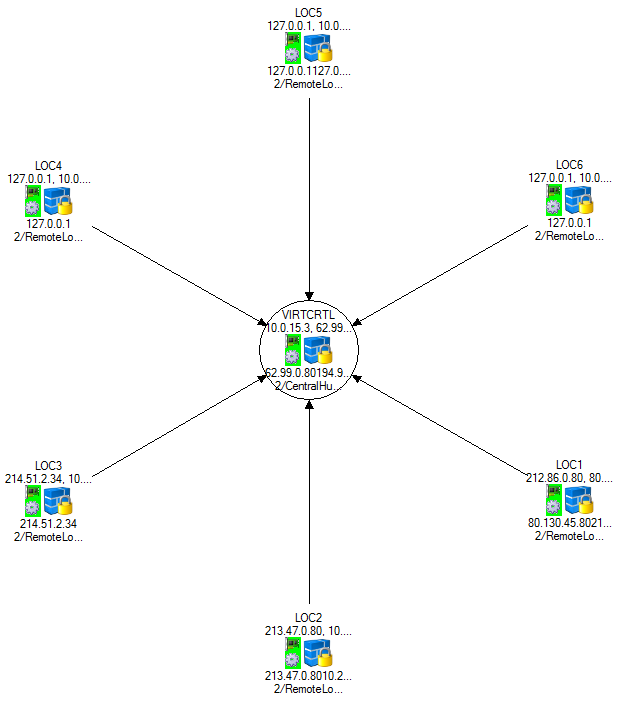
- (optional) Click on the connection between the two VPN services and click on the transport you want to edit. By default, TINA VPN tunnels are created with one transport.
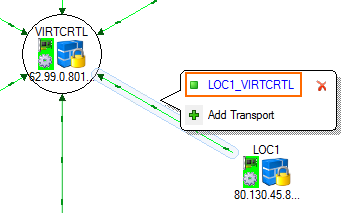
- You can now modify the VPN tunnel as needed:
- Direction – You can create VPN tunnels that use the following modes: active-active, active-passive, on-demand.
Transport Source IP/Interface – If needed, you can modify the transport source IP.
Transport Listening IP/Interface – Reorder the IP addresses so the first IP addresses of every VPN service can reach the Transport Listening IP addresses of all other VPN services.
- Click Send Changes and Activate.
Go to the VPN > Site to Site and verify that all tunnels are up.

Step 4. (optional) Add Transports to the VPN Tunnels
If you are using multiple Internet connections, you can use SD-WAN to create multiple transports for the VPN tunnels. The dynamic tunnels consolidate the static VPN tunnels into one transport per SD-WAN class (e.g., bulk0 or quality0), instead of replicating their transport configuration. This also means you have to configure all firewalls except the VPN hub to act as a SD-WAN secondary. The transport is then chosen by the connection object of the CloudGen Firewall initiating the connection.
For more information, see How to Configure SD-WAN Using the VPN GTI Editor and Dynamic Mesh VPN Networks.
Step 5. Create Three Custom Connection Objects on the VPN Hub
You must create three custom connection objects on the VPN hub: one that triggers a dynamic tunnel and resets the tunnel timeout, one for traffic going through the dynamic tunnel while not resetting the tunnel timeout, and one for the traffic that should always be relayed through the VPN hub.
Step 5.1 Dynamic Mesh Connection Object SD-WAN Primary with Idle Timeout Reset
Only connections matching an access rule with the dynamic mesh and SD-WAN primary options enabled in the SD-WAN settings of the custom connection object on the VPN hub will trigger a new dynamic VPN tunnel. All other traffic will continue to go through the VPN hub. The connection objects on the remote units (SD-WAN secondaries) do not need to be enabled because they are learned automatically from the VPN hub acting as the SD-WAN primary. For traffic matching access rules using this connection object to keep the dynamic tunnel open, Prevent tunnel timeout must be enabled.
- Go to Assigned Services > Firewall > Forwarding Rules.
- In the left menu, click Connections.
- Right-click in the Connections and click New > Connection.
- Enter a Name. E.g.,
DynMeshNoSNAT Select Original Source IP.
- In the SD-WAN VPN Settings section, click Edit/Show. The SD-WAN Settings window opens.
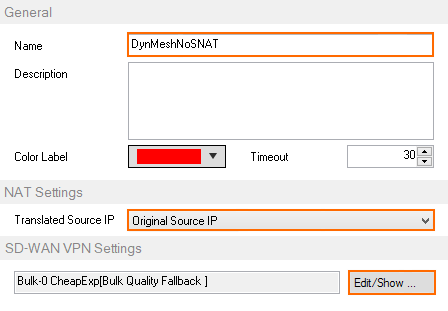
- Set the SD-WAN Learning Policy to Primary (propagate SD-WAN settings to partner).
In the Dynamic Mesh section, enable Allow Dynamic Mesh and Trigger Dynamic Mesh. - Enable Prevent Tunnel Timeout.
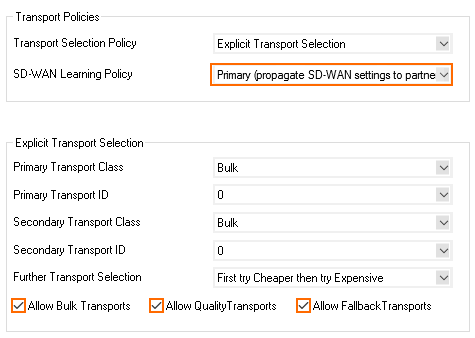
- Click OK.
- Click OK.
- Click Send Changes and Activate.
Step 5.2 Dynamic Mesh Connection Object SD-WAN Primary with No Idle Timeout Reset
Only connections matching an access rule with the dynamic mesh and SD-WAN primary options enabled in the SD-WAN settings of the custom connection object on the VPN hub will trigger a new dynamic VPN tunnel. All other traffic will continue to go through the VPN hub. The connection objects on the remote units (SD-WAN secondaries) do not need to be enabled because they are learned automatically from the VPN hub acting as the SD-WAN primary.
- Go to Assigned Services > Firewall > Forwarding Rules.
- In the left menu, click Connections.
- Right-click in the Connections and click New > Connection.
- Enter a Name. E.g.,
DynMeshNoTimeout Select Original Source IP.
- In the SD-WAN VPN Settings section, click Edit/Show. The SD-WAN Settings window opens.
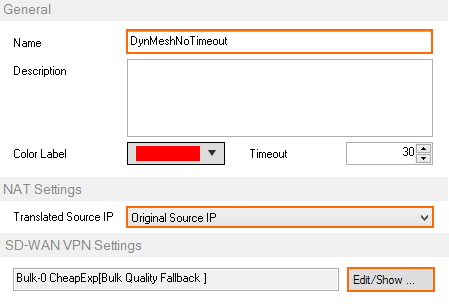
- Set the SD-WAN Learning Policy to Primary (propagate SD-WAN settings to partner).

- In the Dynamic Mesh section, enable Allow Dynamic Mesh.
- Disable Prevent tunnel timeout.

- Click OK.
- Click OK.
- Click Send Changes and Activate.
Step 5.3. Create a SD-WAN Primary Connection Object for the VPN Hub for VPN Relaying
For all services that should not go through the VPN tunnel, use a custom connection object with the SD-WAN Learning Policy set to Primary. Traffic matching an access rule that uses this connection object will not trigger a dynamic tunnel. Instead, it continues to go through the VPN hub.
- Go to Assigned Services > Firewall > Forwarding Rules.
- In the left menu, click Connections.
- Right-click in the Connections and click New > Connection.
- Enter a Name. E.g.,
TIPrimaryNoSNAT Select Original Source IP.
- In the SD-WAN VPN Settings section, click Edit/Show. The SD-WAN Settings window opens.

- Set the SD-WAN Learning Policy to Primary (propagate SD-WAN settings to partner).
- Verify all checkboxes in the Dynamic Mesh section are disabled.

- Click OK.
- Click OK.
- Click Send Changes and Activate.
Step 6. Create three access rules on the VPN hub
Create an access rule that triggers the dynamic tunnel and another that relays the rest of the traffic.
Step 6.1. Create an Access Rule on the VPN Hub to Trigger a Dynamic Tunnel
Create an access rule on the VPN hub that will trigger a dynamic tunnel.
- Action – Select PASS.
- Source – Enter all Local Networks for all remote firewalls and the Local Networks for the VPN hub.
- Service – Select the services that should trigger a dynamic tunnel.
- Destination – Enter all Local Networks for all remote firewalls and the Local Networks for the VPN hub.
- Connection Method – Select the DynMeshNoSNAT custom connection object created in step 5.1.
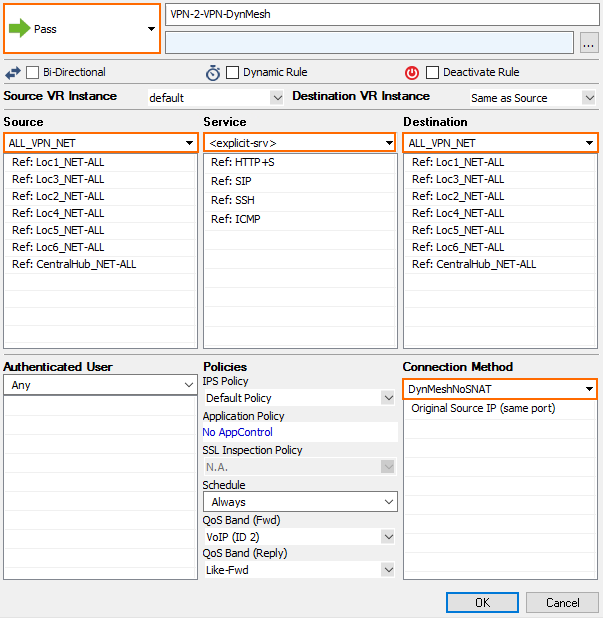
Step 6.2. Create an Access Rule on the VPN Hub to Trigger a Dynamic Tunnel without Resetting the Idle Timeout of the Dynamic Tunnel
Create an access rule on the VPN hub that will trigger a dynamic tunnel.
- Action – Select PASS.
- Source – Enter all Local Networks for all remote firewalls and the Local Networks for the VPN hub.
- Service – Select the services that should go through the dynamic tunnel if it is up, otherwise go through the VPN hub.
- Destination – Enter all Local Networks for all remote firewalls and the Local Networks for the VPN hub.
- Connection Method – Select the DynMeshNoTimeout custom connection object created in step 5.2.
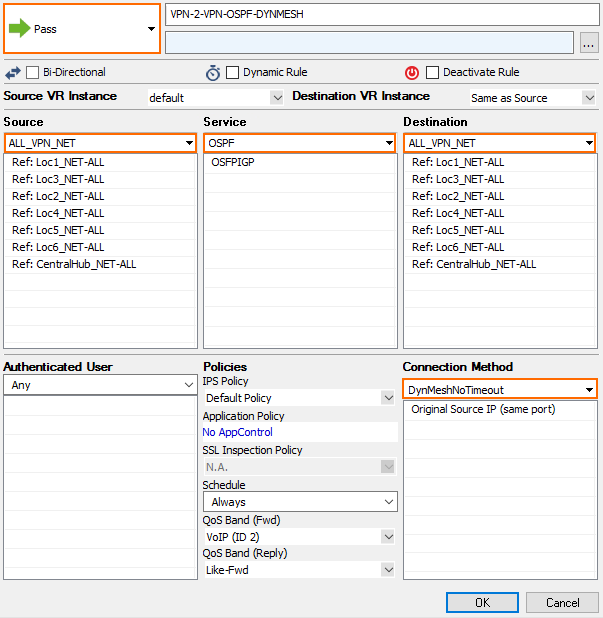
Step 6.3. VPN Relaying Without Triggering a Dynamic Tunnel
Create an access rule on the VPN hub that allows the remote firewalls to send traffic to other remote firewalls through the VPN hub. Place this access rule below the rule triggering the dynamic tunnels.
- Action – Select PASS.
- Source – Enter all Local Networks for all remote firewalls and the Local Networks for the VPN hub.
- Service – Select Any.
- Destination – Enter all Local Networks for all remote firewalls and the Local Networks for the VPN hub.
- Connection Method – Select the TIPrimaryNoSNAT custom connection object created in Step 5.2.
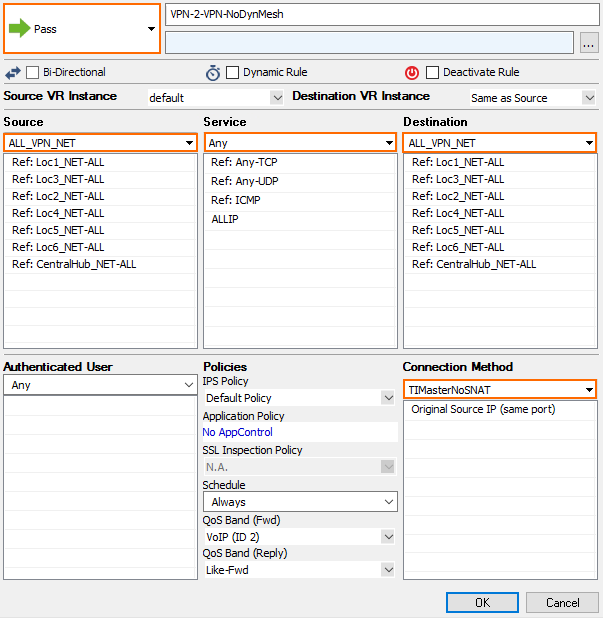
Step 7. Create Access Rules on the Remote Firewalls
Create an access rule to allow traffic into the VPN tunnel on every remote CloudGen Firewall.
- Action – Select PASS.
- Source – Enter all Local Networks.
- Service – Select Any or the service that should go over the dynamic mesh.
- Destination – Enter all Local Networks for all remote firewalls and the Local Networks for the VPN hub.
- Connection Method – Select Original Source IP. Verify that the SD-WAN Learning Policy is set to Secondary.
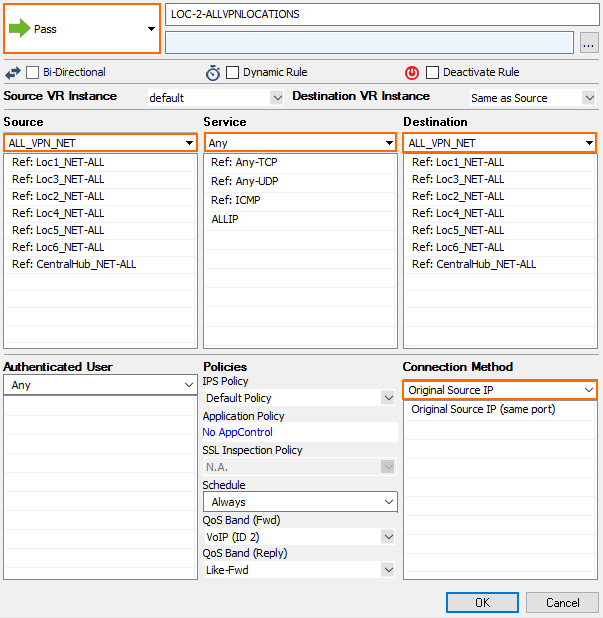
You now have a dynamic mesh VPN network that automatically creates dynamic VPN tunnels when traffic matches an access rule using a dynamic-mesh-enabled connection object. Go to VPN > Site-to-Site to see all dynamic tunnels on the remote firewalls or on the VPN hub. Dynamic tunnels are terminated automatically after no traffic has passed through them for the Dynamic Mesh Timeout defined in the GTI VPN Group.

